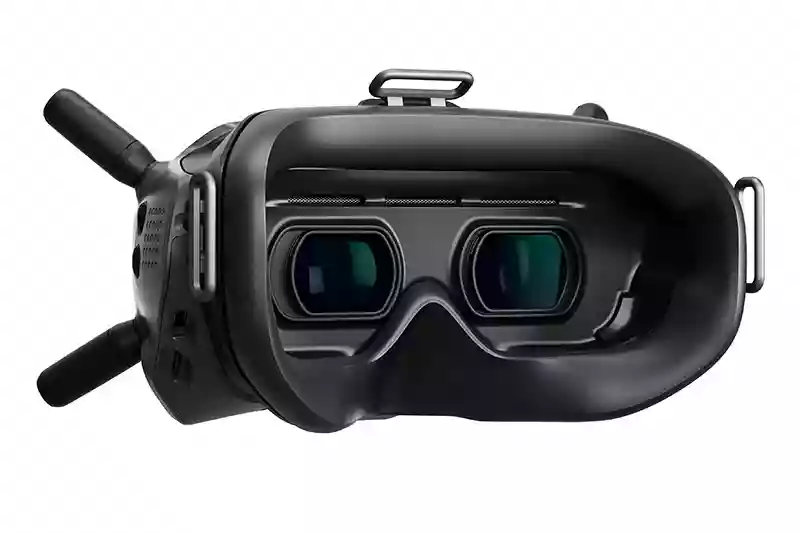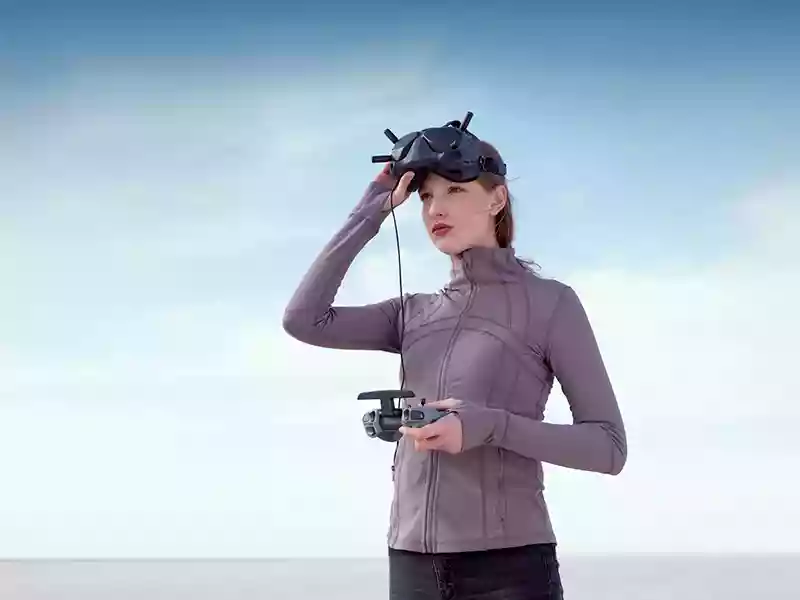- Call us: 01444 237070
- Contact Us
- Stores
- Sign In / Register
-
- Back
- Used Cameras
- Used Accessories
- Used Lenses
- Used Video
- Used Film Equipment
- Used Stock Alert
- Used Blank Test
- Sell or Part Exchange
- Used Clearance
- Recently Added Used Equipment
- Park Picks
- All Used Black Friday Deals
- Faulty
- Trade-In
- Blog
- New in
- Call us
- Contact us
- Stores
- Sign in
- Categories
- Tips & Inspiration
- Reviews
- News
- Events
- Features
- Buying Guides
- Competitions
DJI FPV Drone Specs
If you're considering the DJI FPV Drone we have the full lowdown on specs, what’s included in the Combo and just how good the first person view flying experience is. Our very own Gareth Evans also got his hands on the new FPV drone for a video review which we’re adding here.
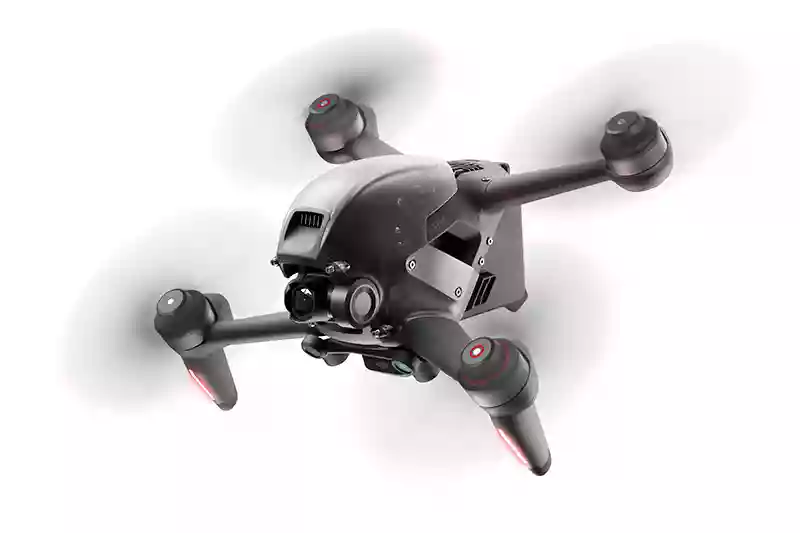
DJI FPV Drone Combo Introduction
First Person View (FPV) drones were developed for pilots to race with a birds eye view from their drone streamed to Goggles. The World Air Sports Federation hosts international drone sports championships which have proven immensely popular, despite being hampered by the global pandemic.
Whilst FPV drones are essential for sports and racing, they are also becoming popular with solo pilots, videographers and for Youtube content creators, as the first person view is so immersive. The pilot wears a set of Googles (Version 2 in the case of DJI’s drone here) which live streams a view directly from the drone. Clearly transmissions need to be as clear and latency free as possible, which is why DJI has included High-gain antennas on the aircraft with three transmitters and four receivers to enhance the signal. The results are impressive with a stable, reliable video feed in HD.
According to the CAA you’ll need eyes on the ground with you if you lose line of sight when flying solo, with a spotter required to assist the pilot. This is because it’s hard to detect other aircraft in the vicinity while you’re wearing goggles which can of course be dangerous. All drones have to be registered as well, although at 795g this aircraft would be registered under old rules in any case. By the way, it looks the absolute business as you can see above.

Can Beginners Fly The DJI FPV Drone?
If you’ve never flown a drone before the idea of donning goggles and heading out into the wilderness can seem daunting. A flight mode for newcomers is included N Mode, which offers immersive flight combined with traditional drone controls and DJI safety features like obstacle sensing. Speed is capped and the drone restricts whacky input from the pilot, ensuring even beginners can get the hand of flying with a first person view.
Once mastered there’s a new flight mode which DJI developed specifically for their FPV drone, which is called S mode. This is a hybrid flight mode which combines the freedom of flying manually with simplified controls, with similar handling to previous DJI drones. Pro pilots can of course fly in M Mode for fully manual piloting with customisable parameters.
Whatever skills you have DJI has included a panic button, basically an emergency brake and hover feature. Simply press the button on the remote controller while flying in any mode at any speed, and the aircraft will stop and hover stably within a few seconds. This is very nice indeed, especially as we can be racing at extremely high speeds of nearly 90mph.
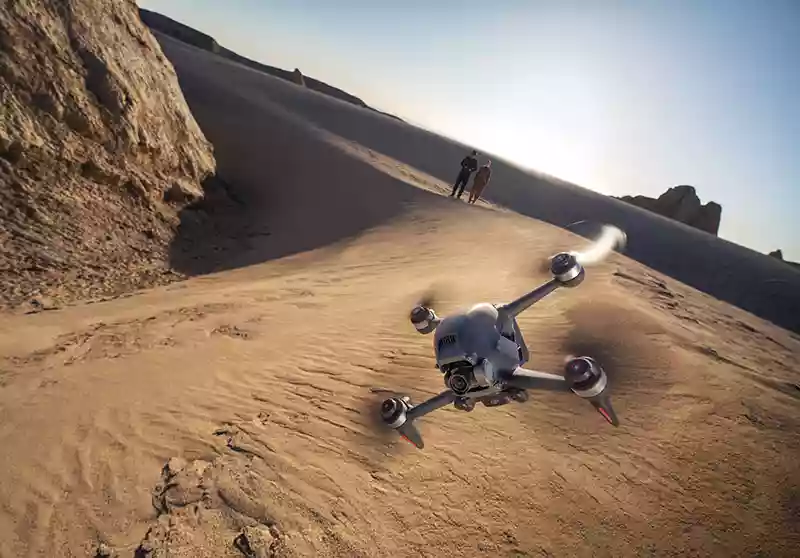
DJI FPV Drone FAQ’s
Question: Can you use a regular controller with the FPV drone?
Answer: Yes, DJI FPV is compatible with the regular DJI Motion Controller.
Question: Does DJI FPV support GPS?
Answer: Yes, it uses GPS + GLONASS + GALILEO.
Question: Can the DJI FPV aircraft hover?
Answer: Yes, N mode and S mode support auto-hovering through the VIO + TOF + GPS system.
Question: Can the drone camera settings be adjusted manually?
Answer: Yes
Question: Can the DJI FPV aircraft directly connect to DJI Fly via smartphone?
Answer: No. You can connect it to a computer via USB-C cable to read the microSD card, or launch the free DJI Assistant 2 for firmware updates.
Question: Can DJI FPV Goggles V2 connect to a smartphone?
Answer: Yes, when the goggles are connected to your smartphone, you can use the DJI Fly app to activate and update firmware for the aircraft, goggles, and remote controller. You can also download and playback footage.
Question: What is the difference between DJI FPV Goggles and DJI FPV Goggles V2?
Answer: FPV Goggles support 5.8 GHz, whereas FPV Goggles V2 support both 2.4 and 5.8 GHz with auto switching.
Question: What is the difference between recording with the DJI FPV Goggles V2 and with the camera on the drone?
Answer: The goggles only record transmitted footage in a resolution of 810p/60fps, and do not support RockSteady EIS; Shooting with the aircraft camera supports up to 4K/60fps and RockSteady EIS.
Question: Do the DJI FPV Goggles V2 support audio transmission?
Answer: Yes with real time stereo sound
Question: Does DJI FPV support obstacle detection?
Answer: Yes, DJI FPV comes with forward and downward vision sensors. The aircraft automatically decelerates when detecting objects in N mode, but will not stop completely unless controlled instructed by the pilot.
Question: Can I adjust the interpupillary distance of the DJI FPV Goggles V2?
Answer: Yes, between 58-70 mm.
DJI FPV Drone Review | Next Level Drone Videography
Built for sport racing
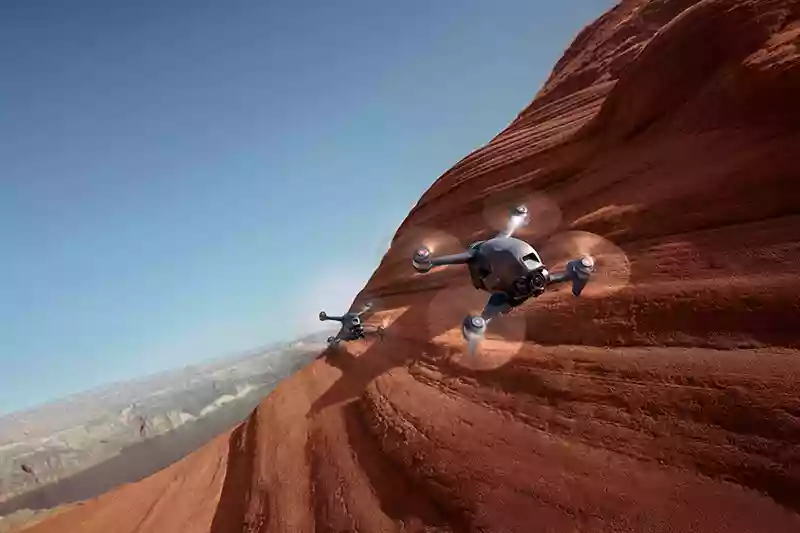
Now for the Full DJI FPV Drone Specs
|
Camera |
Sensor |
1/2.3” CMOS with Effect pixels: 12 million |
|
Lens |
FOV: 150° 35mm Format Equivalent: 14.66 mm Aperture: f/2.8 Focus Mode: Fixed Focus Focus Range: 0.6 m to ∞ |
|
|
ISO |
100-12800 |
|
|
Shutter Speed |
1/50-1/8000 s |
|
|
Still Photography Modes |
Single shot |
|
|
Max Image Size |
3840×2160 |
|
|
Photo Format |
JPEG |
|
|
Video Resolution |
4K: 3840×2160 at 50/60fps FHD: 1920×1080 at 50/60/100/120fps |
|
|
Video Formats |
MP4/MOV (H.264/MPEG-4 AVC, H.265/HEVC) |
|
|
Max Video Bitrate |
120 Mbps |
|
|
Color Profile |
Standard, D-Cinelike |
|
|
RockSteady EIS |
Yes |
|
|
Distortion Correction |
Yes |
|
|
Supported File Formats |
exFAT (recommended) FAT32 |
|
|
Gimbal |
Mechanical Range |
Tilt: -65° to 70° |
|
Controllable Range |
Tilt: -50° to 58° |
|
|
Stabilization |
Single-axis (tilt), electronic roll axis |
|
|
Max Control Speed |
60°/s |
|
|
Angular Vibration Range |
±0.01° (N mode) |
|
|
Electronic Roll Axis |
Available (can stabilize footage when the aircraft is tilted at angles of up to 10°) |
|
|
Aircraft |
Takeoff Weight |
Approx. 795 g |
|
Dimensions |
255×312×127 mm (with propellers) 178×232×127 mm (without propellers) |
|
|
Diagonal Distance |
245 mm |
|
|
Max Ascent Speed |
M mode: No limit S mode: 15 m/s N mode: 8 m/s |
|
|
Max Descent Speed |
M mode: No limit S mode: 10 m/s N mode: 5 m/s |
|
|
Max Speed |
140 kph; M mode: 39 m/s (27 m/s in Mainland China) S mode: 27 m/s N mode: 15 m/s |
|
|
Max Acceleration |
0-100 kph: 2 s (in ideal conditions while flying in M mode) |
|
|
Max Service Ceiling Above Sea Level |
6,000 m |
|
|
Max Flight Time |
Approx. 20 mins (measured while flying at 40 kph in windless conditions) |
|
|
Max Hover Time |
Approx. 16 mins (measured when flying in windless conditions) |
|
|
Max Flight Distance |
16.8 km (measured while flying in windless conditions) |
|
|
Max Wind Speed Resistance |
39-49 kph (25-31 mph) |
|
|
Operating Temperature |
-10° to 40° C (14° to 104° F) |
|
|
Transmitter Power (EIRP) |
2.400-2.4835 GHz FCC: ≤ 31.5dBmCE: ≤ 20 dBmSRRC: ≤ 20 dBmMIC: ≤ 20 dBm 5.725-5.850 Ghz FCC: ≤ 31.5 dBmCE: ≤ 14 dBmSRRC: ≤ 25.5 dBm |
|
|
Number of Antennas |
Four |
|
|
GNSS |
GPS+GLONASS+GALILEO |
|
|
Hovering Accuracy Range |
Vertical: ±0.1 m (with Vision Positioning) ±0.5 m (with GPS positioning) Horizontal: ±0.3 m (with Vision Positioning) ±1.5 m (with GPS positioning) |
|
|
Supported SD Cards |
microSD (up to 256 GB) |
|
|
Internal Storage |
N/A |
|
|
Sensing System |
Forward |
Precision Measurement Range: 0.5-18 m Obstacle Sensing: Available in N mode only FOV: 56° (horizontal), 71° (vertical) |
|
Downward (dual vision sensors + TOF) |
TOF Effective Sensing Height: 10 m Hovering Range: 0.5-15 m Vision Sensor Hovering Range: 0.5-30 m |
|
|
Downward Auxillary Light |
Single LED |
|
|
Operating Environment |
Refers to non-reflective, discernible surfacesDiffuse reflectivity >20% (e.g. walls, trees, people) Adequate lighting conditions (lux >15 in normal indoor lighting conditions) |
|
|
Charger |
Input |
100-240 V, 50/60 Hz, 1.8 A |
|
Output |
Battery charging interface: 25.2 V ± 0.1 V 3.57 A ± 0.1 A (high current)1 A ± 0.2 A (low current) USB Port: 5V/2A (×2) |
|
|
Rated Power |
90 W |
|
|
Intelligent Flight Battery |
Battery Capacity |
2000 mAh |
|
Voltage |
22.2 V |
|
|
Max Charging Voltage |
25.2 V |
|
|
Battery Type |
LiPo 6S |
|
|
Energy |
44.4 Wh@ 0.5C |
|
|
Discharge Rate |
Standard: 10C |
|
|
Weight |
295g |
|
|
Charging Temperature |
5° to 40° C (41° to 104° F) |
|
|
Max Charging Power |
90 W |
|
|
Video Transmission |
Operating Frequency |
2.400-2.4835 GHz 5.725-5.850 GHz |
|
Communication Bandwidth |
40 MHz (Max.) |
|
|
Live View Mode |
Low-Latency Mode: 810p/120fps ≤ 28ms High-Quality Mode: 810p/60fps ≤ 40ms |
|
|
Max Video Bitrate |
50 Mbps |
|
|
Transmission Range |
10 km (FCC), 6 km (CE), 6 km (SRRC), 6 km (MIC) |
|
|
Audio Transmission Support |
Yes |
|
|
DJI FPV Goggles V2 |
Weight |
Approx. 420g (headband and antennas included) |
|
Dimensions |
184×122×110 mm (antennas excluded) 202×126×110 mm (antennas included) |
|
|
Screen Size |
2-inches (×2) |
|
|
Screen Refresh Rate |
144 Hz |
|
|
Communication Frequency <sup>[1]</sup> |
2.400-2.4835 GHz 5.725-5.850 GHz |
|
|
Transmitter Power (EIRP) |
2.400-2.4835 GHz FCC: ≤ 28.5 dBmCE: ≤ 20 dBmSRRC: ≤ 20 dBmMIC: ≤ 20 dBm 5.725-5.850 GHz FCC: ≤ 31.5 dBmCE: ≤ 14 dBmSRRC: ≤ 19 dBm |
|
|
Communication Bandwidth |
40 MHz (Max.) |
|
|
Live View Mode |
Low-Latency Mode: 810p/120fps ≤ 28ms* High-Quality Mode: 810p/60fps ≤ 40ms* * A 150° FOV is available when shooting at 50 or 100 fps. For other frame rates, the FOV will be 142°. |
|
|
Max Video Bitrate |
50 Mbps |
|
|
Transmission Range <sup>[2]</sup> |
10 km (FCC), 6 km (CE), 6 km (SRRC), 6 km (MIC) |
|
|
Video Format |
MP4 (Video format: H.264) |
|
|
Supported Video and Audio Playback Formats |
MP4, MOV, MKV (Video format: H.264; Audio format: AAC-LC, AAC-HE, AC-3, MP3) |
|
|
Operating Temperature |
0° to 40° C (32° to 104° F) |
|
|
Power Input |
Dedicated DJI Goggles batteries or other 11.1.-25.2 V batteries. |
|
|
FOV |
FOV: 30° to 54°; Image size: 50-100% |
|
|
Interpupillary Distance Range |
58-70 mm |
|
|
Supported microSD Cards |
microSD (up to 256 GB) |
|
|
DJI FPV Goggles Battery |
Capacity |
1800 mAh |
|
Voltage |
9 V (Max.) |
|
|
Type |
LiPo 2S |
|
|
Energy |
18 Wh |
|
|
Charging Temperature |
0° to 45° C |
|
|
Max Charging Power |
10 W |
|
|
Battery Life |
Approx. 110 minutes (measured in an environment of 25°C at maximum brightness level) |
|
|
DJI FPV Remote Controller |
Operating Frequency |
2.400-2.4835 GHz 5.725-5.850 GHz |
|
Transmitter Power (EIRP) |
2.400-2.4835 GHz FCC: ≤ 28.5 dBmCE: ≤ 20 dBmSRRC: ≤ 20 dBmMIC: ≤ 20 dBm 5.725-5.850 GHz FCC: ≤ 31.5 dBmCE: ≤ 14 dBmSRRC: ≤ 19 dBm |
|
|
Max. Transmission Distance |
10 km (FCC), 6 km (CE), 6 km (SRRC), 6 km (MIC) |
|
|
Gimbal Dimensions |
190×140×51 mm |
|
|
Weight |
346 g |
|
|
Battery Life |
Approx. 9 hours |
|
|
Charging Time |
2.5 hours |
|
|
Motion Controller |
Model |
FC7BMC |
|
Weight |
167 g |
|
|
Operating Frequency Range |
2.400-2.4835 GHz; 5.725-5.850 GHz |
|
|
Max Transmission Distance (unobstructed, free of interference) |
10 km (FCC), 6 km (CE/SRRC/MIC) |
|
|
Transmitter Power (EIRP) |
2.4 GHz: ≤28.5 dBm (FCC), ≤20 dBm (CE/ SRRC/MIC) 5.8 GHz: ≤31.5 dBm (FCC), ≤19 dBm (SRRC), ≤14 dBm (CE) |
|
|
Operating Temperature Range |
-10° to 40° C (14° to 104° F) |
|
|
Battery Life |
300 minutes |
|
|
microSD card |
Supported microSD cards |
Max 256 GB UHS-I Speed Grade 3 |
FPV Accessories
Of course DJI has made the usual accessories available with a spare FPV drone battery, FPV Propellers, prop guards and replacement FPV goggles battery as well as a FPV Fly More kit.
But there is one new accessory which we think is a must-have. You have to get the new DJI Motion Controller. This is a new concept in aircraft control which makes flights easier and more intuitive, working in a similar way as a game controller. This is a first from DJI with directional point, squeeze control, tilting and side to side motion control. We recommend this to take the immersive experience to a whole new level and it’s a shame it’s not included in the Combo kit, but everything else is included.
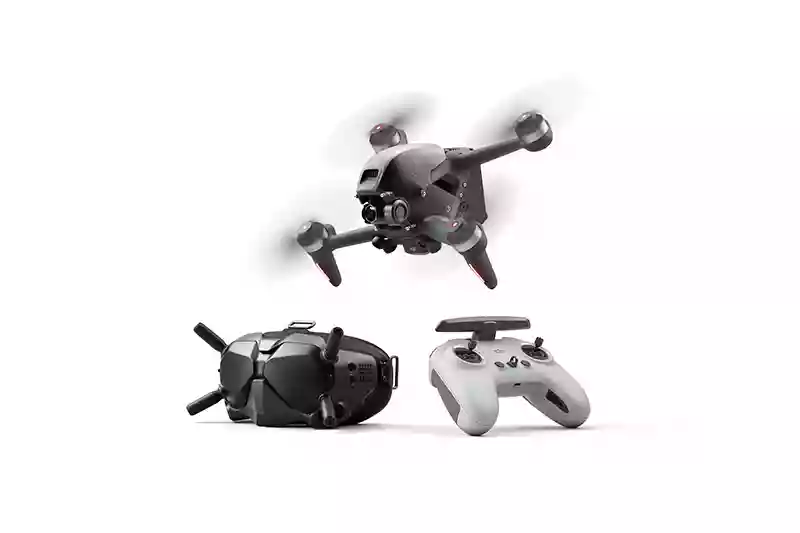
What comes in the FPV Combo Kit?
Everything you need is in the box all fully assembled ready to head out and start flying.
- The drone + 1 battery as well as power adapter and AC cable
- FPV Remote Controller 2 with Spare Control Sticks (Pair)
- FPV Goggles V2 which include Dual Band Antenna, Battery, power cable, foam padding and headband
- USB-C Cable and USB-C OTG Cable
Conclusion
First Person View drones are becoming increasingly popular because pilots feel more connected to the views their drones are capturing. It does make complete sense to have a birds eye view as we fly over courses and landscapes, putting us right up there in the aircraft. For sports and competitions it is essential with obstacles to avoid, however even when capturing content for Youtube or commercial purposes it can make a more engaging experience. Images and video can be framed intuitively as we are seeing the end results in realtime streamed to Goggles, much like looking through an EVF on a camera.
DJI has invested heavily in technology to ensure the transfer of images from the drone to the pilot are clear, fast and provide the most natural view possible. They’ve done an amazing job with it too with High definition, low latency, long-distance transmission that also has strong anti-interference capabilities. With ends to lockdown in sight this is the perfect time to once again think about heading out to enjoy flying and competing and the DJI FPV drone is definitely the drone we would pick if FPV is appealing.
For anyone still on the fence why not read our previous drone blogs including DJI Mavic Air 2 Drone and Fly More Combo Full Specs and a Long Term review of the DJI Mavic 2 Pro. Our camera gear reviews section is packed with handy reviews of all the latest gear too!
Share this post:
By Nick Dautlich on 02/03/2021
Nick Dautlich
Senior Content Writer and Product Reviewer
Nick Dautlich is the Senior Content Writer and Product Reviewer at Park Cameras, with over 15 years of photography experience. A Sony Imaging Professional and expert reviewer, Nick has worked with major brands such as Canon, Sony and Nikon. His work is also featured on Vanguard World UK’s website, Capture Landscapes, and Shutter Evolve. Nick’s photography includes National Trust projects and magazine covers and he is passionate about landscapes and storytelling. Nick also enjoys hiking and teaching his children about nature. Learn more on his profile page.

Trade in your old equipment
Fast and easy trade in service ensures your old gear is collected efficiently and you are paid quickly! It's very simple to trade in your unwanted photography gear. Just head over to our dedicated Sell or Part Exchange page, fill out the details, and we'll get back to you with an offer for your old gear. Take the cash, or put it towards the cost of your new gear. It's up to you! Find out more
sign up to the newsletter
Keep up to date on the latest photography news, events and offers. Sign up now

